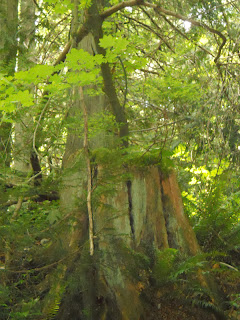I. Lake Padden
Lake Padden is a gathering place for outdoor loving Bellinghamsters (yes, "Bellinghamsters"). Think of it as a more peaceful and wild version of Seattle's Greenlake. Like Greenlake, it is a city park and a place of recreation. It fits Bellingham's description of itself: the city of subdued excitement. On this day, July 13th, there were kayakers, people fishing, swimmers, sunbathers, dog walkers (and a dog park), joggers, and people strolling or gazing out at the water. The footpath around the lake is about 2.75 to three miles.
Unlike Greenlake, Lake Padden feels removed from the city. It is girded and swathed by alders and willow and Mountain Ash (aka Rowan) at the lakeshore, and a forest of fir and cedar which rises up on the surrounding hills.
a fairly young Douglas Fir stand on the north shore
II. The Padden Creek and Trail
Several trails lead away from the lakeside. One follows Padden Creek, which flows from the west end and empties into Bellingham Bay. This is an easy, gravel covered trail which gives a beautiful sense of what a diverse, regenerating forest can be. At this time of year, the creek is just a trickle of water, but it has cut an impressive gorge over time.
The forest along Padden Creek is a mix of Red Cedar, Douglas Fir, Western Hemlock, and maples. Many of the trees are young - evidence of past logging, but their are a few that are a meter across and must go back to the beginning of the last century or the end of the 1800s.
The canopy is dense and the light is filtered. On a hot day, it is a peaceful oasis.
About a half mile (a km) below the lake, the creek and forest continue on the south side, but the north side of the trail opens up into tiny farms...the sound of roosters and tthe sight ofpastures.
The forested part of the trail ends abruptly and becomes an Inter-Urban Trail which will take you down slope to Fairhaven and the bay, while occasionally touching or crossing Padden Creek.
III. Canopy
Although many of the Red Cedar and Douglas fir are 25 meters (80 feet) tall, the Big Leaf Maple can also attain the upper canopy.
As the name implies, the Big Leaf Maple is known for its huge leaves. Some of these are as big as a dinner plate.
In the understory, there is a different species of maple, the Vine Maple. This is one of the first trees to show fall colors each year. Its leaves become a dark red or rich orange.
The forest floor has a luxurient covering of Salal and Sword Fern, both shown in the following photo.
IV. Epiphytes and Nurse Stumps
Padden Creek Trail is a great place to see nurse stumps. These are the decaying remains of old trees that give their nutrients to the new trees growing out of them. There are also epiphytes everywhere you look along the creek. Ferns and mosses cover the trunks and branches of trees. This will give the walker a small taste of what they can see in the Hoh River Valley rainforest in the Olympic National Park.
Every stump becomes the soil and the substrate for its own garden. This stump holds a miniature forest of huckleberry and moss and one oddly placed stone.
This nurse stump of dead Red Cedar has two trees growing out of it: a Douglas Fir on the left and a Birch tree on the right.
This nurse stump also has two trees of different species growing from it: a Red Cedar and a Western Hemlock (on the right). As these trees mature, the stump will be recycled. It will gradually disappear.
This was an 'off-shoot' of the originally tree, which is now dead. This one is particularly weird in its cantilever trunk...new life growing out of old.
Vine Maple growing from a nurse stump.
Padden Creek Trail is a beautiful, easy walk. It is just one of dozens of city park, greenway, and inter-urban trails you can take in Bellingham.




































